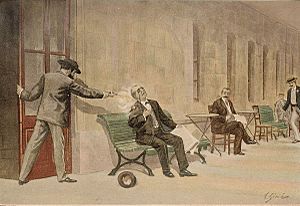Assassination of Antonio Cánovas del Castillo facts for kids
Italian anarchist Michele Angiolillo ended the life of Spanish Prime Minister Antonio Cánovas del Castillo on August 8, 1897. This happened in Guipúzcoa, where the Prime Minister was on vacation at the Santa Águeda spa. Angiolillo was quickly arrested, put on trial, and executed. He said he did it to get revenge for the harsh treatment of people during the Montjuic trial.
Contents
Why It Happened
Around the late 1800s, the city of Barcelona in Spain saw many violent acts by people called anarchists. Anarchists are people who believe that society should not have a government or rules.
One of the most serious events was a bombing in June 1896 during a religious parade. Six people died and 42 were hurt. After this, the police reacted very strongly. This led to a famous event known as the Montjuïc trial.
The Montjuïc Trial
In the Montjuïc trial, about 400 people were arrested and held in Montjuïc Castle. They were treated very badly during questioning. Many people believed their confessions were forced.
Out of those arrested, 28 were sentenced to death, and five were executed. Another 59 were given life imprisonment, and 63 were found innocent but sent away to the Spanish Sahara.
This trial caused a big stir around the world. Many people doubted if the trials were fair because of the harsh methods used. Newspapers in Spain also spoke out against the government. A journalist named Alejandro Lerroux wrote many stories about the people who were treated badly.
The Attack
Michele Angiolillo was a printer from Italy. The Italian police knew him as an anarchist. In 1895, he left Italy to avoid jail time for writing articles that went against the government. He was probably in Barcelona when the 1896 bombing happened.
He then traveled to France, Belgium, and England. In London, he heard many stories about the unfair treatment during the Montjuïc trial. There, he bought the pistol he would use.
Angiolillo's Journey
When Angiolillo arrived in Paris, he met Ramón Emeterio Betances. Betances was a representative for Cubans who wanted independence from Spain. Angiolillo asked him for money to travel to Spain. He planned to attack the Spanish Queen Regent, Maria Christina of Austria, and Prime Minister Antonio Cánovas del Castillo. Betances gave him some money but said he did not support such violent acts.
In Paris, Angiolillo also met Henri Rochefort. Rochefort was the editor of a newspaper that had strongly spoken out against the Montjuïc trial.
Angiolillo then traveled to Madrid. There, he met a journalist named José Nakens. Angiolillo pretended to be a journalist named Emilio Rinaldini and asked Nakens for help. Nakens gave him some money. As Angiolillo was leaving, he told Nakens about his plan to attack the Queen Regent, the Prime Minister, and even the young king, Alfonso XIII, who was only 11 years old. Nakens did not believe him. He later said that even if he had believed him, he would not have stopped him, calling it a "political crime."
The Day of the Attack
On August 8, 1897, at noon, Angiolillo approached Prime Minister Cánovas del Castillo. The Prime Minister was reading a newspaper on a bench at a resort in Guipúzcoa. Angiolillo fired three shots at him.
The police immediately arrested Angiolillo. During his trial, he said he committed the crime as revenge for the harsh treatment of people in the Montjuïc trial. He blamed the Prime Minister for this. Angiolillo also spoke about his sympathy for those living in poverty and his belief in anarchism.
He claimed he acted alone, though some people doubted this because he had discussed his plans with others. He was sentenced to death. The sentence was carried out by garrote vil (a method of execution) on August 19, 1897. This was only eleven days after the attack.
What Happened Next
Newspapers in Europe and America wondered if the attack was part of a large international anarchist plan. The Times newspaper said it was likely the work of one person. It asked police to be careful but not to take extreme measures. The newspaper explained the attack by reminding people of the harsh treatment during the Montjuïc trial. This event continued to affect Spain's image even after Cánovas's death.
The attack on Cánovas briefly stopped the wave of anarchist violence in Spain during the 1890s. However, these attacks started again in 1903 and continued for many decades. This was different from countries like France and the United States, where such violence decreased.
One reason for this might be how Spanish authorities handled the situation. Historian Juan Avilés Farré suggests their response was "barbaric, illegal, and ineffective." Instead of good police work, they often used mass arrests and harsh questioning without much evidence. For example, Barcelona's police force was not big enough to handle the challenges. In contrast, France used its police and legal system to convict and execute four terrorists fairly. This led to an end of anarchist violence in France by 1894.
See also
 In Spanish: Asesinato de Cánovas del Castillo para niños
In Spanish: Asesinato de Cánovas del Castillo para niños
Images for kids



